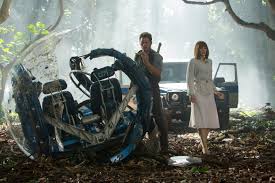
Let’s get this out of the way; Jurassic World has Indominus
Rex sized flaws. However, it rectifies the mistakes of the previous sequels, as
it harks back to the Jurassic Park of 1993. It roars for the original, yet it
hatches its own originality. This summer we walk with (and run away from) the
extinct once more, and it is mighty fun.
The Indominus Rex is our genetically modified dinotagonist.
That’s right, I present to you a hybrid of ‘dinosaur’ and ‘protagonist’. If
they can mix up science over on Isla Nublar then I can mix up language in this
review. It is a seriously ‘clever
girl’ with rather unfortunate abilities, bequeathed to it by scientists, who were
delegated the Frankenstein experiment as dinosaurs alone just ‘aren’t that exciting
anymore’. It has not yet been revealed to the tourists of Jurassic World, a
twenty-first century prehistoric theme park, built on the remnants of Jurassic
Park.
This blend of animal traits, which includes a capacity to
alter blood temperature, allows the film’s threat to coax itself out of
solitary confinement. The Indominus Rex kills ‘for sport’, and as it rages
through the restricted area of the island, on towards Jurassic World, danger is
afoot, and the action starts to speak much louder than words.

I haven’t even mentioned our cast yet, led by Chris Pratt, as
Owen Grady, who in this role tries on the shoes that he’ll surely fill in a
soon-to-be-announced Indiana Jones franchise. Allegedly. He has a totemic
relationship with Velociraptors and rides a Triumph Scrambler. Pratt’s charisma
is crisper than high-definition. The actor is armed with charm, which
translates in his flirtation with Jurassic World’s operation manager, Claire
Dearing (Bryce Dallas-Howard). His belittling of her is refuted by her actions
amidst
the action, especially when
the film reaches its climax. Dearing’s nephews, Zach (Nick Robinson) and Gray
(Ty Simpkins), are treated with a VIP visit to the island, and almost treat
themselves to the roaming science project.
Dallas-Howard is fine as Dearing, not quite endearing, but
fine. She does not stumble in her high heel athleticism and proves a match for
Grady, which is no mean feat. And
she is NOT Jessica Chastain,
for your information. Both Robinson and Simpkins portray their sibling dynamic
very well indeed; bicker, attitude, bicker again, more attitude, then a rush of
loyalty. Simpkins rips off the ‘annoying kid’ tag he wore in Iron Man 3, and
Robinson faultlessly authenticates the late teen phase. If Jurassic World
continues to fly high at the Box Office, it will live up to the title of
Robinson’s previous film, Kings of Summer. The blockbuster is alive with
characters, well, some perish of course, but many are introduced, though aren’t
fully realised in the script. Vincent D’Onofrio, Omar Sy, Irrfan Khan, the
returning BD Wong, Judy Greer and Jake Johnson, are arguably all surface with
little substance.
The flaws are as palpable as the product placements (I’ll
get to that). They all trickle down from the biggest of all which is, after
everything that has happened in the last twenty-three years, how is a park like
this still running? At least Alan Grant has finally got the picture, and
declined a ticket this time around.
Jurassic World is a haven for product placement; Beats by
Dre, Starbucks and Mercedes are three of about three hundred advertisements
that the camera gamely points at. In fact, I would place a wager that product
placement made more of a killing out of this movie than the Indominus and
Mosasaurus combined (the Mosasaurus was the big sea creature, which isn’t
technically a dinosaur, another flaw). Nonetheless, is the product placement a
bit tongue-in-cheek?
A
Washington Post article explains:
“The dinosaur park is strapped for funding
and takes on corporate sponsors: Its star dinosaur exhibit becomes ‘Verizon
Wireless Presents The Indominus Rex.’ A side character jokes they should have
gone even further, naming a dinosaur ‘Pepsi-saurus.’”
The theory makes sense, and it
also quashes my point about the biggest flaw of all (although there are still
minor and major details that make more noise than a Velociraptor mating call).
But my final argument is: who really cares? Colin Trevorrow, the director of
Jurassic World whose prior picture, Safety Not Guaranteed, was a darling of
Sundance not so long ago, teases us and enthrals us. He maps the screen with
Spielberg DNA and scatters it with a touch of Trevorrow class. The humans make
us laugh and the genuinely terrifying monster makes us scared. These subjective
reactions were much more important to me than a perforated script and an
advertisement flooding.
There was one scene I had a
problem with, when Claire’s British assistant was torn apart by Pterodactyls
and ravaged by the Mosasaurus, a silly segment that echoed Piranha 3D. Still, Jurassic
World may have closed for now, but I am sure sequels will force it into
re-opening. Biting entertainment.
